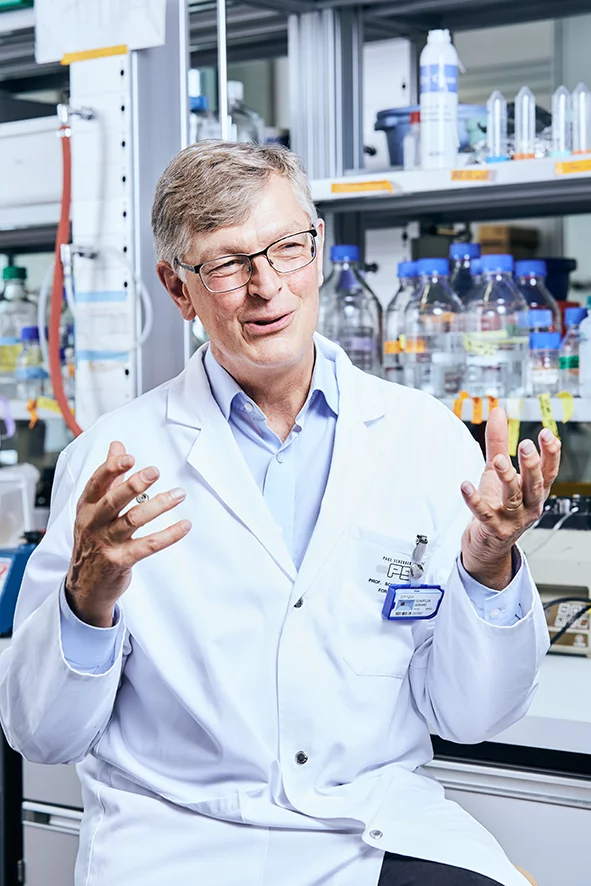Interview with Gebhard Schertler
Gebhard Schertler is head of the research division Biology and Chemistry at the Paul Scherrer Institute PSI and Professor for Structural Biology at ETH Zurich. In this interview he talks about biological research at PSI and the future of drug development.
Gebhard Schertler, one of the core competences of PSI is deciphering the structure of proteins. What makes proteins so interesting?
In biology, proteins make up the workbench of life. They are structural building blocks or active tools that transform materials or transmit signals. Therefore, they are central to understanding the essential processes of life. There's a saying: The language of life is chemistry.
And a great many proteins are catalysts, which enable or regulate this chemistry.
What is the significance of protein research for our everyday life?
Fundamental biology is becoming ever more relevant for the development of new therapeutic options against diseases. Thus, the insights we are gaining about the structure of proteins help to develop better drugs – for example, against cancer or diseases of the eye. But there is even more potential: We are standing at the start of a technological revolution, which could be described as biological systems engineering. Proteins become components in new biological regulatory circuits. For example, today people are thinking about drugs that can be switched on or off with light. At the moment this is possible only to a limited extent, but it will likely become very important in the future; projects at PSI are providing the necessary research infrastructure for these developments.
The buzzword personalised medicine
keeps coming up in connection with the future of diagnostics and therapy. What is meant by this term?
Personalised medicine has different aspects. On the one hand, it refers to a treatment that is tailored to one particular person – that can begin with a genetic test, or with the medical history and imaging techniques: for instance, when precisely defining, in the course of proton therapy at PSI, the three-dimensional zone around the tumour that should be treated. On the other hand, you want to analyse a person's genes and environmental factors as completely as possible and thus find out, for example, whether cancer cells will respond to a particular hormone therapy or not. For me, the essence of it is that in the end, after a precise analysis of the individual patient, an optimal treatment emerges.
And how are researchers at PSI contributing to personalised medicine?
In our fundamental research, we are concerned with how proteins interact with each other. Through analysis we try to determine which protein plays a central role in a disease: This protein is then called the target molecule, because it becomes the attack point for the medical treatment. The researchers here at PSI often play a very important role when such a target molecule has already been identified and subsequently needs to be investigated more precisely, whether structurally, biophysically, or kinetically. The results of these studies then yield clues as to which drugs are most suitable for the treatment.
In this context, what does rational
drug design mean – and what would be the alternative?
In the past, the approach was to try to investigate thousands and thousands of chemical compounds in one big testing procedure – in the hope of identifying, by chance, a single compound that showed the desired effect. Yet this non-rational
approach didn't stand the test. Millions were invested – and in the end, the successes were small. Therefore, today, there is really no longer any alternative to rational drug design where, on the basis of a target molecule, a suitable active ingredient is developed. With this approach we have had good experience with biological agents, for example with antibodies. Once a target molecule has been rationally identified as the cause of a disease, it can be switched on or off with antibodies. There are disadvantages of antibodies in that they generally need to be injected, and may activate undesired immunological reactions. Therefore, most pharmaceutical researchers are always searching for soluble substances that can be taken in tablet form. Here, too, there are major advances – on the one hand through structural biology, on the other through computer modelling of proteins. It's a combination of practical experience and theory that pays off best in the end.
In what other areas is PSI developing personalised medicine?
Above all, radiopharmacy should be mentioned here, where radiopharmaceuticals, radioactively marked active ingredients, are being developed in close collaboration with hospitals. These are used mostly in the diagnosis of cancers, but also increasingly in therapy.
Beyond that, what strategies do you follow within the life sciences research at PSI? Is there a vision that guides the way?
Strategically, we are at the moment strongly focused on making a contribution to personalised medicine. At the same time, besides fundamental questions in structural biology, we will give priority to topics that have relevance for the pharmaceutical industry, and we will intensify our collaboration with hospitals. It is important to understand that the way we gain knowledge is changing. Up to now it was possible to achieve major breakthroughs with individual experimental methods alone. In the future it will become ever more important to find combinations of methods that are best suited to solve a specific problem and to make new findings possible. Therefore, we invest in a broad portfolio of methods. For one, PSI has recently built the free-electron X-ray laser SwissFEL, with which the movement of proteins can be made visible in the form of, one might say, ‘molecular movies’. On another front, structural analysis by means of electron beams is becoming increasingly important – here, too, we are working on new machines. One important goal for the future is to determine the structure of proteins in their natural environment, inside cells.
Interview: Judith Rauch

